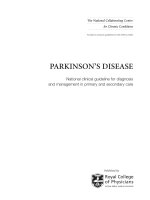Strategic management in travel and tourism
Bạn đang xem bản rút gọn của tài liệu. Xem và tải ngay bản đầy đủ của tài liệu tại đây (833.19 KB, 31 trang )
STRATEGIC MANAGEMENT
IN TRAVEL AND TOURISM
Group 3
Nguyễn Thị Huyền
Trang
Hoàng Thị Minh Ngọc
Lê Thị Loan
Nguyễn Thị Thùy Linh
Đào Thị Thanh Xuân
Chapter 7 :
The external environment for
travel and tourism organizations –
the macro context
Contents
Contents
1. Introduction of
macroenvironment
2. STEEP analysis
3. The relationships
between the STEEP
influences
4. Using the STEEP analysis
Contents
1. Introduction of macroenvironment
What is the macroenvironment?
The broad environment outside of an organization’s
industry and markets.
•
Beyond the influence of the individual organization
but can have significant impact on the
microenvironment
•
Beyond control.
Bring about the birth or death of an entire industry,
make markets expand or contract, determine the
level of competitiveness
A vast amount of information
Conducting macro-environmental analysis
Scanning
Monitoring
Forecasting
Assessing
Scanning macro-
environments for
warning signs and
possible
environmental
changes that will
effect the business
Conducting macro-environmental analysis
Scanning
Monitoring
Forecasting
Assessing
For specific trends
and patterns
Conducting macro-environmental analysis
Scanning
Monitoring
Forecasting
Assessing
Future directions
of environmental
changes.
Conducting macro-environmental analysis
Scanning
Monitoring
Forecasting
Assessing
Current and future
trends in terms of
the effects such
changes would have
on
the organization.
Limitations of macro-environmental
analysis
1
2
3
Extremely complex and at any one time
there may be conflicting and contradictory changes
taking place
The pace of change is increasing and
becoming more turbulent and unpredictable
Uncertainty has some doubt over the
value of carrying out a macro-environmental analysis
Overview of the STEEP influences
◦
Complexity
◦
Four categories are interrelated and constantly
interact with each other
◦
Because of the uncertainty of the effects of macro-
environmental change on the microenvironment
identify and consider the possible outcomes of the
changes
2. STEEP analysis
The extended framework
◦
Social
◦
Cultural
◦
Economic
◦
Physical
◦
Technical
◦
International
◦
Communications and infrastructure
◦
Administrative and institutional
◦
Legal and political
2. STEEP analysis
Figure 7.1 Old and new tourism compared (adapted from
Poon, 1993)
Socio-demographic influences
Social culture
Demography
Social structure
Values, attitudes
and beliefs) –its
impact on demand
for products and
services, attitudes
to work, savings
and investment,
ecology, ethics, etc.
Socio-demographic influences
Social culture
Demography
Social structure
•
the impact of the
size and structure of
the population on the
workforce
•
and patterns of
demand.
Socio-demographic influences
Social culture
Demography
Social structure
the ways in which
the social groups in
a population are
organized
by age, sex,
location, population
density in different
areas, etc
Technological influences
Goods and services.
Operational processes
Information and communications.
Transport and distribution.
4
Society, politics and economics.
Technological influences
Developments in information and
communications technology
Activities are better co-ordinated
Research and development is
speeded up
Changes in transport technology have
revolutionized business ; changed
societies and cultures
Economic influences
Fiscal
policy
Monetary
policy
Revenue
Manage
Expenditure
$$$
Vary
Price
Supply
$$$
Economic influences
When the fiscal & monetary policy work,
they can affect:
Economic growth rates
Levels of income in the economy.
Levels of productivity
Wage levels and the rate of increase in
wages.
Levels of inflation
Levels of unemployment.
Balance of payments
Exchange rates
Economic influences
All of the factors above will affect:
People’s ability to pay for goods and
services
Levels and patterns of demand
Costs of production and
competitiveness
Environmental influences
Natural environment
Change of concern
Built environment
Unifying characteristics
Ecology and ‘green
Issues”
global climate change,
ozone layer depletion,
deforestation, extinction
of species, soil
erosion, desertification,
acid rain, toxic wastes
and water pollution
Environmental influences
Natural environment
Change of concern
Built environment
Unifying characteristics
traffic congestion,
deteriorating
buildings and
historic sites,
poor urban planning,
and visually intrusive
buildings
Environmental influences
Natural environment
Change of concern
Built environment
Unifying characteristics
First, they all have
international dimensions
Second they are not
exclusively tourism
related but nevertheless
have important
implications for tourism
managers amongst
others.
Environmental influences
Natural environment
Built environment
Unifying characteristics
Change of concern
Be aware of the
need to protect
environment
combined desire for
products which are
environmentally
friendly and produced
by ‘green’methods
Laws that influence employment,
consumer protection, health and
safety at work…
Legislation &
regulation
Economic policy
Governement-
owned businesses
Fiscal policy, set policy over the
levels of taxation and expenditure
Nationalized industries
Governments have direct control or influence over:
Political, governmental, legal and regulatory
influences
Governement
international policy
Government intervention to influence
exchange rates, international trade









